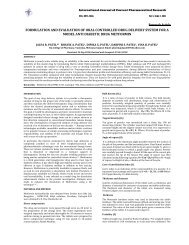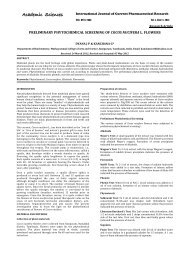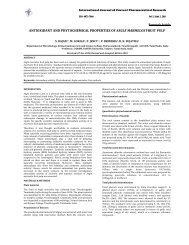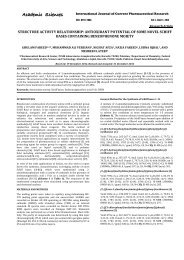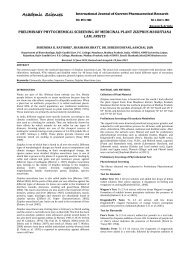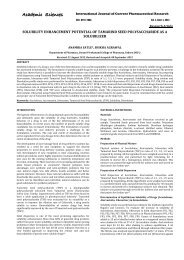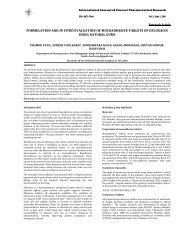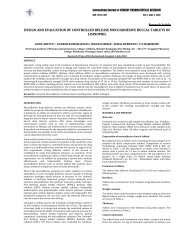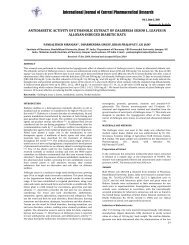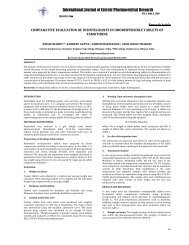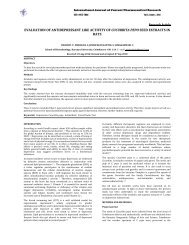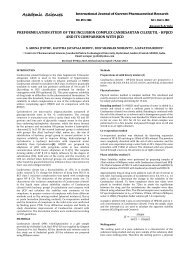preparation and characterizationof ondansetron hydrochloride ...
preparation and characterizationof ondansetron hydrochloride ...
preparation and characterizationof ondansetron hydrochloride ...
Create successful ePaper yourself
Turn your PDF publications into a flip-book with our unique Google optimized e-Paper software.
International Journal of Current Pharmaceutical ResearchVol 2, Issue 2, 2010Research ArticlePREPARATION AND CHARACTERIZATIONOF ONDANSETRON HYDROCHLORIDEMICROSPHERES USING VARIOUS CELLULOSE POLYMERSSUNITHA S 1* , AMARESHWAR P 2 , SANTHOSH KUMAR M 11St.Marys College of Pharmacy, Secunderabad, A.P500025, 2 Osmania University, College of Technology, A.P500007.E Mail: sunithasampathiphd@gmail.comReceived 22 Dec 2009, Revised <strong>and</strong> Accepted 10 Jan 2010ABSTRACTThe present study was aimed to prepare microspheres for sustained release of <strong>ondansetron</strong> <strong>hydrochloride</strong> using various cellulose polymers such asethyl cellulose, cellulose acetate phthalate, cellulose acetate by employing solvent evaporation technique. Microspheres were characterized for theparticle size distribution, wall thickness by scanning electron microscopy (SEM), angle of repose, bulk density, percent drug content, entrapmentefficiency <strong>and</strong> in vitro dissolution studies. Drug excepient compatibility was determined by FTIR <strong>and</strong> DTA. Accelerated stability studies were alsocarried out following ICH Guidelines. SEM revealed that microspheres were found spherical, free flowing <strong>and</strong> porous. The entrapment efficiency <strong>and</strong>wall thickness was found in between 69.44% & 40.35%, 117.57μ & 71.82μ respectively. The drug release was extended maximum upto 12hourswith ethyl cellulose FTIR <strong>and</strong> DSC results showed <strong>ondansetron</strong> was compatible with excepients. The curve fitting data revealed that the releasefollowed first order kinetics <strong>and</strong> higuchi’s <strong>and</strong> peppa’s plots stated non‐fickian <strong>and</strong> diffusion controlled.Keywords: Microspheres, <strong>ondansetron</strong> <strong>hydrochloride</strong>, Cellulose polymers, Sustained release, Stability studies.INTRODUCTIONOndansetron is a novel <strong>and</strong> specific antagonist of the 5‐HT receptorindicated for chemotherapy‐ induced nausea <strong>and</strong> vomiting in cancerpatients 1 . The half‐life in plasma has been reported to be 4‐5 hours.The shorter biological half‐life <strong>and</strong> frequent dosing inchemotherapy‐induced nausea <strong>and</strong> vomiting make it as an idealc<strong>and</strong>idate for sustained release drug delivery system. Therefore theobjective of the work is to provide a sustained action pharmaceuticalcomposition containing <strong>ondansetron</strong> in a modified releaseformulation, to maintain the blood levels of the active ingredient fora prolonged period of time. Microencapsulation is of the techniqueto sustain the release rate of the drug. Microencapsulation is definedas the application of a thin coating to individual core material thathas an arbitrary particle size range from 5 to 5000μm 2, 3 .Microencapsulation can improve the absorption of a drug <strong>and</strong>reduce side effects such as irritation of the gastric intestinalmucosa 4 . Only limited studied on <strong>ondansetron</strong> extended releaseformulation has been carried out using cellulose derivatives. Rectal 5<strong>and</strong> nasal 6 absorption of <strong>ondansetron</strong> have been reported.MATERIALS AND METHODSMaterialsOndansetron <strong>hydrochloride</strong> was obtained as a gift sample from Dr.Reddy’s (Hyderabad). Cellulose acetate phthalate <strong>and</strong> Celluloseacetate was obtained from Nacto pharma (Hyderabad) Ethylcellulose as a gift sample from Matrix Laboratories (Hyderabad). Allthe solvents are procured of Merck. All other chemicals <strong>and</strong> reagentsused in the study were of analytical grade.MethodsPreparation of microspheresOndansetron microspheres were prepared by the emulsion solventevaporation method. The polymers (ethyl cellulose, celluloseacetate, <strong>and</strong> cellulose acetate phthalate) 7‐9 were dissolved inacetone; by stirring the mixture at 800rpm the author dispersed thedrug particles in liquid paraffin (50% heavy+50% light) containing1% w/w polysorbate. 10‐12 The polymer solution was added slowly tothe drug dispersion by means of a burette. The mixture was agitatedat room temp (25°c) until the acetone (polymer solvent) wasevaporated. 13‐15 The rate of stirring was kept constant for all thebatches <strong>and</strong> for all the methods <strong>and</strong> the ratio of drug to polymer wasvaried as (D: P as 1:1, 1:2, 1:3) <strong>and</strong> labeled as F1 to F9. Theliquid paraffin was decanted <strong>and</strong> the microspheres werecollected, washed with petroleum ether to remove anyremaining oil phase <strong>and</strong> dried under, reduced pressure for atleast 12 hours. Table No. 1.Table 1: Formulation tableFormulationDrug Ethyl Cellulose Cellulose acetate Cellulose acetate Drug: Polymer(mg)(mg)(mg)phthalate (mg)F1 300 300 ‐ ‐ 1:01F 2 300 600 ‐ ‐ 1:02F 3 300 900 ‐ ‐ 1:03F 4 300 300 ‐ 1:01F 5 300 ‐ 600 ‐ 1:02F 6 300 ‐ 900 ‐ 1:03F 7 300 ‐ 300 1:01F 8 300 ‐ 0 600 1:02F 9 300 ‐ ‐ 900 1:0344
CHARACTERIZATION OF MICROSPHERESScanning electron microscopy (SEM)Morphological characterization of the microspheres was carriedusing scanning electron microscopy (SEM‐LEICA, S430, U.K.). ForSEM the double sided sticking tape coated with gold film (thickness200nm) was used under the reduced pressure (0.001torr).Particle Size analysisDetermination of stability of the microspheresAll the batches prepared were analyzed for particle size.Microspheres were placed on the set of st<strong>and</strong>ard sieves rangingfrom sieve No. 16# – 60#. The sieves were arranged in such a waythat in descending order of the mesh size 16# on the top <strong>and</strong> 60#mesh in the bottom. The microsphere passed through the set ofsieves <strong>and</strong> the amount retained on each sieve was weighed <strong>and</strong> the RESULTSaverage mean diameter was determined.Assay of <strong>ondansetron</strong> <strong>hydrochloride</strong>To determine the total drug content of the microspheres 100mg ofmicrospheres was ground to a fine powder <strong>and</strong> dissolved in 5ml ofacetone <strong>and</strong> diluted with phosphate buffer pH 7.4 to 100ml. the drugcontent was determined spectrophotometrically at 272nm. Threedetermination of the microspheres content from the same batch foreach ratio <strong>and</strong> method was performed.Encapsulation efficiency (EE)Drug loaded microspheres were weighed <strong>and</strong> dissolved inphosphate buffer PH 7.4 <strong>and</strong> mixture was filtered. The percententrapment was calculated using the Eq (1).Encapsulation efficiency = Actual drug content/Theoretical drugcontent x 100 Eq (1)Wall thicknessThe wall thickness of the prepared microspheres was calculatedusing the Eq (2).h = ř (1‐P) d1/3(Pd2+ (1‐P) d1 Eq (2)Fourier Transforms infrared Spectroscopy (FTIR)The FT‐IR spectra acquired were taken from dried samples. An FT‐IR (Thermo Nicolet 670) spectrometer was used for the analysis inthe frequency range between 4000cm ‐1 <strong>and</strong> 400 cm ‐1 .Differential Thermal Analysis (DTA)DTA of <strong>ondansetron</strong> <strong>hydrochloride</strong> <strong>and</strong> drug loaded microsphereswere performed by using Seiko (Japan) DTA. Samples were sealed inaluminium pans <strong>and</strong> the DTA thermograms were reported at aheating rate of 10°/min from 20°C to 300°C.X ray diffractometer (XRDshimadzu 7000)X ray diffractometry was used for diffraction studies. XRD studieswere performed on the samples by exposing them to cupper (cu kα)radiation (40kv,30mA) <strong>and</strong> scanned from 2°C t0 80°C, 2 theta(θ) at astep size of 0.045° <strong>and</strong> step time of 0.5 sec. XRD analysis wasperformed on the pure drug <strong>and</strong> for the prepared formulation ofmicrospheres with various polymers.In vitro drug release studiesIn vitro dissolution studies were performed using (USP type IIdissolution apparatus). The rotating basket method specified in USP‐XXI at 75 rpm. The microspheres were weighed <strong>and</strong> tied in theTable 2: % drug content, angle of repose, average mean diameter (AMD) <strong>and</strong> wall thicknessmuslin bag <strong>and</strong> placed in the basket. The dissolution medium(900ml) consisted of 0.1M hydrochloric acid for the first 2 hours <strong>and</strong>then changed to phosphate buffer pH 7.4 from the 3 rd hour. Thetemperature was maintained at 37°C. An aliquot of (5ml) samplewas withdrawn at specified time interval <strong>and</strong> replaced with anequivalent volume of dissolution fluid. Drug content was determinedby UV‐Visible spectrophotometer (Schimazdu UV 1700 E 23) at245nm. The release studies were conducted in triplicate.The microspheres prepared in the present study were filled in thehard gelatin capsules (No.1) <strong>and</strong> stored in HDPE container at RT37°C, <strong>and</strong> 45°C for 6 months as per ICH guidelines. The sampleswere then characterized for % drug content.Prepared microspheres were found to be discrete, spherical <strong>and</strong> freeflowing <strong>and</strong> have nearly uniform size. Fig.4, 5. SEM results revealedamong the various formulations the formulation F5 showedmaximum percentage yield <strong>and</strong> F7 formulation showed highest drugentrapment. The average mean diameter of the microspheres wasfound to be ranging between 71.82µ to 117.57μ. Table No. 2. Fig. 2.The FTIR spectra of the pure drug <strong>and</strong> microspheres with polymerswere compared <strong>and</strong> the characteristic peak for microspheres inspectra was found to be super imposable to that of the pure drug.There were no extra peaks, which gave evidence that there was nodrug polymer interaction. The FTIR spectrum of the physicalmixture of drug <strong>and</strong> polymer showed no significant shift orreduction in intensity of peaks of <strong>ondansetron</strong>. A broad b<strong>and</strong> ofbonded ‐OH of <strong>ondansetron</strong> was observed from 3481cm ‐1 to3245.97 cm –1 in pure drug also found in samples <strong>and</strong> a sharpprominent peaks found at 2926cm ‐1 because of –CH stretchingindicating presence of methyl group <strong>and</strong> at 1726 cm ‐1 due to ‐C=Ostretching indicating keto group <strong>and</strong> these peaks are foundprominent <strong>and</strong> clear in sample spectra also. Fig. 6.The X‐ray diffractogram of <strong>ondansetron</strong> confirms its crystallinenature, as evidenced from the number of sharp <strong>and</strong> intense peaks.The diffractogram of ondensetron with polymers showed diffusedpeaks, indicating polymers amorphous nature <strong>and</strong> sharp intensepeaks indicates the crystalline nature of the drug. Diffraction patternof the drug with polymer mixture showed simply the sum of thecharacteristic peaks of pure drug <strong>and</strong> the diffused peaks of polymer,indicating presence of drug in the crystalline state. Diffractionpattern of sample spectra represents availability of crystalline peaksof drug situated at 12.49°, 23.25° <strong>and</strong> 24.13° (2θ) similar to puredrug with corresponding peak intensities of 2598, 3689,<strong>and</strong> 3246linear counts respectively. This indicates crystalline nature of thedrug. The peak intensities for formulation were also measured at thesame 2θ scattered angles of 12.68°, 23.44° <strong>and</strong> 24.46°, <strong>and</strong> thecorresponding linear counts were found to be 664, 744, 677respectively in case of cellulose acetate phthalate, 596, 1025, 765 incase of cellulose acetate microspheres. In case of ethyl cellulosemicrospheres formulations there was a shift of peak withcorresponding 2θ. XRD patterns of ethyl cellulose <strong>ondansetron</strong>formulations exhibits sharp peaks at 2θscattered angle 11.05°,14.72°, 26.20° with corresponding peak intensities 800, 1543, 957linear counts respectively. Based on the peak intensities it showsthat the degree of crystallinity of drug was reduced in presences ofthe polymers <strong>and</strong> the decrease of crystallintiy of the drug is in thefollowing order of CAP > CA > EC. The effect of orientation is muchmore in case of ethyl cellulose formulation of the drug thereby theoverall intensity of the drug decreased. Fig. 8.Formulation %DC Angle of repose AMD μ Wall thicknessF1 59.75 29.24 394.41 71.82F 2 44.22 28.16 410 74.82F 3 40.35 26.83 424.81 77.36F 4 65.32 29.76 476.03 102.2F 5 69.65 29.32 493 105.96F 6 62.65 28.6 547.47 117.57F 7 52.56 29.52 343.5 71.7F 8 55.33 30.24 392.8 81.99F 9 56.02 29.33 404.99 84.5445
Table 3: Curve fitting data for all formulations from F1F9First order Equation Higuchi’s Equation Peppa’s double Log PlotRateRateFormulationRegressionRegressionRegressionSlope constantSlope constantSlopecoefficient (R(K) mg. hr 1)coefficient (R(K) mg. hr 1)coefficient (R 2 )F1 0 1.989 0.938 2.413 7.615 0.915 0.559 0.932F2 0.002 1.993 0.939 1.889 7.709 0.889 0.574 0.906F3 0 1.984 0.966 1.409 4.093 0.905 0.449 0.892F4 0.006 2.203 0.925 6.022 3.264 0.962 0.505 0.902F5 0.004 2.038 0.982 5.336 1.875 0.978 0.524 0.98F6 0.003 2.076 0.917 4.704 3.091 0.98 0.585 0.997F7 0.003 2.153 0.764 5.162 ‐7.081 0.976 0.573 0.979F8 0.004 2.24 0.876 6.069 ‐16.58 0.986 0.66 0.995F9 0.004 2.103 0.901 5.685 ‐15.31 0.969 0.662 0.985The DTA thermograms proved the compatibility of the drug <strong>and</strong>polymers used where no deviations were found in the graph of thedrug with polymer in comparison with pure drug <strong>and</strong> the mid pointsof the peak was found at same temperature in between 90ºC ‐110ºC<strong>and</strong> 190ºC ‐210ºC. Fig. 7.Maximum release of <strong>ondansetron</strong> <strong>hydrochloride</strong> from the variousformulations was achieved with in 12‐14 hours or longer. Fig. 3. Therelease mechanism of the <strong>ondansetron</strong> formulation was determinedby comparing their respective correlation coefficients. Drug releasefrom microspheres prepared by using ethyl cellulose gave goodrelease rate retardation when compared to other polymers. Fromthe release profiles it can be understood that the polymer usedinfluences the release rate of the drug a lot.DISCUSSIONThe formulation followed first order release kinetics, higuchi’s <strong>and</strong>peppas release plots stated non‐fickian <strong>and</strong> diffusion controlled.Table No. 3. The release mainly depended on the ratio of thepolymer. In <strong>ondansetron</strong> spectrum C‐H, O‐H, N‐H b<strong>and</strong>s were found.The same b<strong>and</strong>s were also found in the spectra of the formulationsindicating that there was no drug‐polymer interaction. Theaccelerated stability studies showed the stable nature of the drug<strong>and</strong> showed a good correlation between the original <strong>and</strong> the agedsamples. Good entrapment efficiency was observed. SEMdemonstrated the spherical nature of the microspheres <strong>and</strong> thepresence of the drug particles on the surface. Fig. 4, 5.Fig. 1: Particle size distribution of prepared microsphereFig. 2: % Yield <strong>and</strong> Encapsulation efficiency46
Fig. 3: Cumulative % drug release of prepared microspheres F1F9Fig. 4: SEM of ethyl cellulose microspheres of <strong>ondansetron</strong>47
Fig. 5: SEM photographs of cellulose acetate phthalate microspheres of <strong>ondansetron</strong>Fig. 6: IR Graphs of ondensetron Pure Drug, Drug+ EC, Drug+CAP <strong>and</strong> Drug+CAFig. 7: TGA Graphs of ondensetron Pure Drug, Drug+ EC, Drug+CA <strong>and</strong> Drug+CAP48
Fig. 8: XRD overlay graph of ondensetron Pure Drug, Drug+ EC, Drug+CA <strong>and</strong> Drug+CAPCONCLUSIONThe <strong>ondansetron</strong> <strong>hydrochloride</strong> microspheres sustained drugrelease for 12 hours or longer thereby it could be capable ofreducing the frequency of administration <strong>and</strong> the dose‐dependentside effects with the repeated administration of conventional<strong>ondansetron</strong> tablets. This type of sustained formulation will bebetter suitable for the cancer patients. No drug polymer interactionwas found <strong>and</strong> formulations remained stable over a long period oftime.REFERENCES1. Markham A, Sorkin EM. Ondansetron: an update of itstherapeutic use in chemotherapy‐induced <strong>and</strong> postoperativenausea <strong>and</strong> vomiting. Ind Drugs 1993; 45: 931‐952.2. Lachman L, Liberman HA, <strong>and</strong> Kanig JL. The Theory <strong>and</strong>practice of Industrial Pharmacy. 2 nd ed. Philadelphia: Lea <strong>and</strong>Febiger; 1986. p. 412‐29.3. Ertan G et al. Sustained‐Release microcapsules ofNitrofurantoin <strong>and</strong> Amoxicillin: Preparation, in vitro releaserate kinetics <strong>and</strong> Micrometric studies. J Microencapsulation1997; 14(3): 379‐388.4. Lie SP et al. Recent Advances in microencapsulationTechnology <strong>and</strong> equipment. Drug Dev Ind Pharm 1988; 14(3):353‐376.5. Hsyu PH et al. Comparision of the pharmacokinetics of<strong>ondansetron</strong> solution when administered intravenously, orallyto the colon <strong>and</strong> to the rectum. Pharm Res 1994; 11: 156‐159.6. Hussain AA et al. Nasal absorption of <strong>ondansetron</strong> in rats: analternative route of drug delivery. Cancer ChemotherPharmacol 2000; 45: 432‐434.7. Merkel HP, Speister P. Preparation <strong>and</strong> in vitro evaluation ofcellulose acetate phthalate. J Pharm Sci 1973; 62(10): 1444‐1448.8. Othmer Kirk. Encyclopedia of chemical technology (volume‐5).3 rd ed. New York: Wiley Interscience publication; 1979.9. IBM, U.S. Patent, 3173878, 1965.10. Beyger JW, Nair JG. Some factors affecting themicroencapsulation of Pharmaceuticals with cellulose acetatephthalate. J Pharm Sci 1986; 75(6): 573‐578.11. Farid D, Nokhodchi. Dissolution of compacted aspirinmicrocapsules. Ind J Pharm Sci 1991; 53(5): 222‐223.12. Maharaj I, Nairn JG, Cambell JB. Simple rapid method for the<strong>preparation</strong> of enteric coated microcapsules. J Pharm Sci 1984;73(1): 39‐42.13. Gene L et al. Microencapsulation of keterolac tromethamine bymeans of a coacervation phase separation technique inducedby the addition of non‐solvent. J Microencapsulation 1998;15(1): 45‐53.14. Ndesendo VMK et al. Microencapsulation of chloroquinediphosphate by eudragits RS‐100. J Microencapsulation 1996;13(1): 1‐8.15. Pongpaibul Y et al. Preparation <strong>and</strong> in vitro dissolution ofpropanolol microcapsules. Int J Pharm Sci 1986; 33(1&3): 243‐248.49



